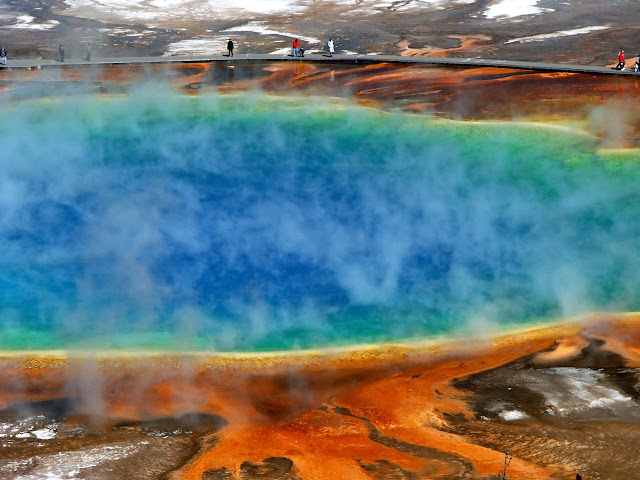The iron rim is made slightly smaller than the diameter of
the wooden wheel. The rim is heated and this hot iron rim is then placed on a wooden wheel and cooled by pouring water over it. On cooling, the iron rim contracts and holds the wheel
firmly.
Riveting of metal
plates
A red-hot rivet is passed through the holes in the two
plates/sheets. While still red hot it is hammered nearly flat. When the rivet
cools down, it contracts and pulls the two plates together very firmly.
To remove a stuck
stopper or cap from a bottle
A metal cap stuck on a glass bottle/stuck stopper can be
removed from the bottle by pouring hot water on the cap/neck of the bottle. When hot water
is poured over the cap/neck of the bottle, it expands and the cap/stopper gets
loosened and can be removed easily.
Laying of rail tracks
Laying of telephone and
Electric transmission wires
When the telephone or telegraph wires are laid in summer they
are kept slightly loose to allow for contraction in winter. Similarly, if
they are laid in winter they are kept very tight to follow expansion
during summer.
Laying of the cement floor
The cement floor is laid in small blocks leaving a very small
space in between the blocks to allow the expansion and not crack the floor
during the expansion in summer.
Expansion of fluids
Liquids have no definite length or area but have definite
volume. So that a liquid expands only in volume, that expansion is called cubical expansion. Different liquids have different rates of expansion, for the
same rise in temperature.
Gases have no definite shape but have a definite volume in
an enclosed vessel. When gases are heated they expand, i.e., they have cubical
expansion in gases is very large as compared to the solids or liquids.
Transmission of heat
“The phenomenon of transfer from a hotter body to a colder
body is called transfer of heat”. There are three modes of transfer of heat
1. Conduction
2. Convection
3. Radiation
Conduction
The process of transmission of heat in solids without the
actual movement of particles from their positions is called the conduction of heat.
A medium is required for the transfer of heat by conduction.
Therefore conduction is not possible in a vacuum. In solids, heat is transferred mainly by the process of conduction. Heat can be conducted
from one body to another only if they are in contact with each other at
different temperatures.
The substances that allow the heat energy to flow through
them easily are called good conductors of heat or simply conductors. All metals
are good conductors of heat. Silver is the best, copper is next, followed by
aluminium, iron and lead.
The substances, which do not allow the heat energy to flow
through them easily are called bad conductors of heat or heat insulators.
Substances such as glass, wood, cloth, air, pure, water, wax, paper, clay etc.,
are the bad conductors of heat.
Liquids (except mercury) are usually the poor conductors of
heat. Gases are still poorer conductors of heat as compared to liquids. Ebonite
and asbestos are the worst conductors of heat.
 |
| lake hot stream |
Convection
Convection is the node of heat transfer in liquids and gases
taking place by the actual movement of molecules from one part to another. A
medium is required for the transfer of heat by convection.
Heat cannot be transferred is always vertically upwards. By
the process of convection, the heat transmission is always vertically upwards.
Land breeze
The cold air blowing from land towards the sea during the night is
called a land breeze.
At night, the land cools more quickly than the seawater.
Thus the air above the sea being warmer rises up and the cooler air from the
land surface blows towards the sea to take its place. This sets up convectional currents
that form the land breeze.
Sea breeze
The cold air blowing from the sea towards the land during the
day is called the sea breeze.
During this time, the land becomes more heated than the sea. The
air above the land expands rises up and colder air from the sea surface blows
towards the land to take its place. This sets up convectional currents which
form the sea breeze.
Radiation
Radiation is the process of transfer of heat from a hot body
to a cold body directly without heating the space in between the two bodies. It
does not require any medium in between. The sun’s heat energy passes through
this vacuum and reaches up without heating the region in between.
Heat radiation
Travel with the velocity of light (i.e.,
3x108 m s-1)
Heat radiation can travel through a vacuum.
Do not heat the material through
which they pass.
Travel in straight lines.
Heat radiation can travel in all
directions.
Objects having a dull black colour are good absorbers/emitters of heat. Objects having a shiny white colour are bad absorbers/emitters of heat.




